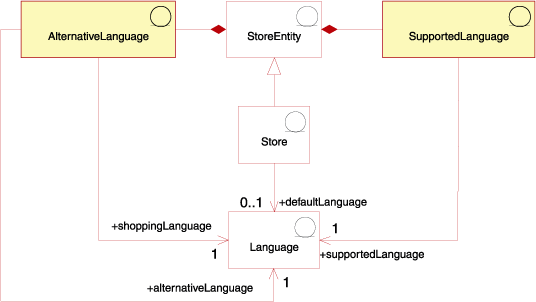Language assets
A Supported Languages package. Supported languages are specific to a particular Store, and thus the Supported Languages package is shown as dependent on the Store.
In HCL Commerce, your site can define many languages which can be used within it. At instance creation, the LANGUAGE table is populated to support thirteen languages including German, Polish, Russian, Romanian, Traditional and Simplified Chinese, Japanese, Korean, Italian, French, Spanish, Brazilian Portuguese, and English. Sites can define additional languages, or dialects of existing languages, to tailor the way information is presented to customers from different cultures or demographics.
This section describes the relationships and associations language has to a store and other assets. The following diagram depicts the language asset information model.

There are four classifications of languages in HCL Commerce.
Each one of these classifications performs a different role in the store. All languages are stored in the LANGUAGE table.
- Default language
- A default language is associated with each store. This is the language that the store has chosen to use as its main language, and will be the language displayed to customers that do not explicitly choose a shopping language. The default language for a store is implicitly supported by the store; that is, the store must always be able to display information in the default language, or one of its alternative languages, if any are defined in the LANGPAIR table. When information is not available in one of its supported languages, or alternative languages, the information will be displayed in the default language.
- Supported language
- The STORELANG table indicates the languages each store supports. A store must be able to display information in its supported languages, or one of their alternative languages, if any are defined in the LANGPAIR table. A store also supports all languages supported by its store group.
- Alternative language
- When information is not available in the one of the supported languages the store tries to display the information in an alternative language, if it is available. A store can specify the sequence in which to try each of its alternative languages. The alternative languages for a store include the alternative languages for its store group. Alternative languages can be useful when some information is available in only one language, but should be made available to customers shopping in a different, related, language. This might be the case when, for example, not all information has yet been translated into all supported languages, or when, for example, two very similar dialects of the same language are supported, sometimes with identical information.
- Shopping language
- The language that is used when displaying pages to a particular customer. If the customer's preferred language is supported by the store or site, then the preferred language is used as the shopping language. Otherwise, the shopping language is the default language for the store or site.